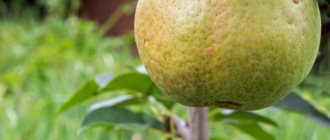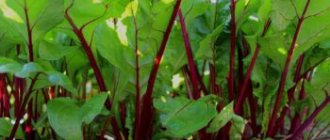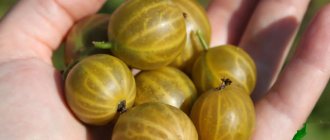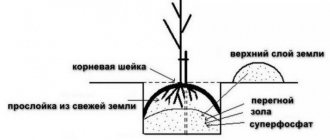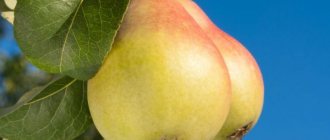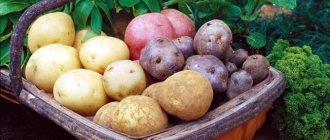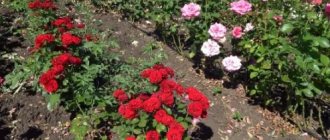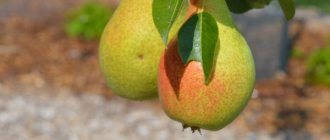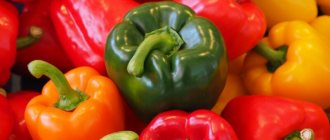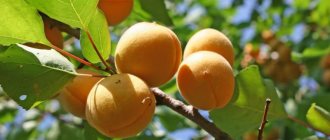Description, distinctive features of winter pears
Pear trees have always been less in demand by gardeners than apple trees, this is explained by their poor resistance to frost. But thanks to the persistence of breeders, today there are varieties that can winter in central Russia. Now pears are grown everywhere.
The undoubted advantages of winter pear varieties are:
- shelf life up to six months;
- frost resistance of pear trees;
- pleasant taste and pronounced aroma of fruits after ripening;
- excellent preservation of fruits, making it possible to transport them over long distances;
- the possibility of processing and preserving canned food.
Old varieties are gradually losing their production value. As an example, the Bere winter Michurina variety, bred by the famous breeder, was preserved only in old gardens; it is no longer propagated by nurseries.
New varieties of late pears have the highest quality. Pears have anti-sclerosis and diuretic effects, strengthen the walls of capillaries. The fruits contain a lot of valuable nutrients, tannins, trace elements and vitamins.
Late ripening pears contain 30.7% dry matter, 7.05% sugars, 0.12% acids, 3.3 mg/100 g of ascorbic acid.
According to 3. A. Sedova and 3. F. Osinova
https://bibliotekar.ru/grusha/4.htm
Moreover, each variety of winter pears has its own characteristics.
Far Eastern
Early winter fruitful variety of pears. The fruits are small, regular pear-shaped, yellow, with numerous brown inclusions. Their flesh is white, juicy, with dense hard lumps. Pears are very tasty, sweet and sour, with a pleasant aroma and aftertaste (just let them sit). The advantages of the variety include high winter hardiness and absolute resistance to scab.
| Entry into fruiting | Tree height (m) | Fruit weight (g) | Harvest | Shelf life (days) | |
| For 4-5 years | 2-3 | 80-100 | Third ten days of September | 50-70 | |
The main representatives of winter varieties
Late ripening pears are divided into three groups based on properties such as shelf life:
- early winter - stored in the cellar or refrigerator until the Christmas holidays;
- winter - lie in storage until early spring;
- late winter (Tikhonovka, Izumrudnaya, Izyuminka Kryma, Maria, Dekanka winter, etc.) - under suitable conditions they can survive until the May Day holidays.
Early winter varieties produce a harvest from the beginning of September. The collected fruits are stored until approximately the New Year. It is recommended to eat them no earlier than November, only then will the fruits be able to gain sweetness and aroma.
curé
On the spreading branches of a tree of this variety, fruits grow in whole bunches, their weight, on average, is 180 - 200 grams. Ripen by the end of September. Even though they will look green, they need to be collected.
It is best to pick pears from the Cure tree when they just begin to show a faint blush.
During the ripening process, the fruits will become yellow and softer, but this will not happen earlier than after three weeks. Their shelf life is only two 2 months. Cure pears have excellent productivity - at the very peak of its development, the pear tree yields about three hundred kg per season. However, this plant will require a lot of heat in the summer.
Chizhovskaya
The variety was bred at the Moscow Agricultural Academy named after K.A. Timiryazev and included in the State Register in 1993. The crown of the tree is of medium density, the fruits are not very large - an average of 110 grams. They ripen in early September. The color is green, with small subcutaneous speckles; after ripening, a yellowish tint appears, with small reddish blush stripes.
The Chizhovskaya variety has strong fruits and is resistant to scab and unfavorable conditions
A variety for universal use. The pulp of ripe Chizhovskaya pears is juicy, slightly oily, with sourness. At approximately zero temperatures, the harvest of such pears will last from one and a half to four months. The peculiarity of the variety is resistance to disease and annual yield, unlike other varieties. Also, trees of this pear variety have good frost resistance.
November
The variety was included in the State Register in 1974. The fruits of the Noyabrskaya variety are medium-sized, weighing about 70 grams, slightly ribbed. Their color is greenish, with a slight pinkish blush. The fruits are collected from the tree at the very beginning of October, ripening occurs by the beginning of December. Ripe pulp is very juicy, sweet, with mild sourness.
Several years ago we collected three large buckets of Noyabrskaya pears. We decided not to process them in any way, but to try to save them for the winter. They lay in a cool basement (somewhere around +3) for several weeks. Knowing that the consumer maturity of this variety begins at the beginning of December, we got several pieces in the first days. After trying, we realized that their time had not come. Disappointed, we forgot about them until the very last days of December. And only when they took them to the New Year’s table did they understand what the real taste of winter pears is. I assure you that their taste and smell are best revealed only in the last days of the year!
The fruits of “Noyabrskaya” are juicy, tasty and good in compotes, jams, preserves and dried
The variety is well suited for long-term transportation and trade. Resistant to infectious diseases and scab. The yield is high, but not uniform - the next year, after a good harvest, the tree can rest.
The middle subgroup of winter pear varieties, which is called “winter,” is distinguished by the fact that its varieties are stored until March.
Kyrgyz winter
Developed in Kyrgyzstan, but is also well suited for regions with unfavorable conditions. Trees of this variety are of medium height, form a pyramidal crown, and are characterized by very dense attachment of fruits to the branch. Therefore, when pears ripen, they do not fall from the branches. The fruits reach 200–250 grams. They are harvested in October when their color turns pink.
The fruits of the Kyrgyz winter variety are perfectly preserved in a regular home refrigerator even until the beginning of April
After several weeks of ripening they acquire an orange color with a reddish blush. Slightly tart, sweetish. The pulp is light, dense, coarse-grained.
The variety is stored in cellars until spring. Its peculiarity lies in its beautiful appearance. Therefore, pears of the Kyrgyz winter variety are traditionally used for commercial cultivation.
Rossoshanskaya late
Bred at the Rossoshansk Experimental Horticulture Station. The fruits of the variety are not too elongated, large, weighing about 300 grams or more. The color is green at harvest, and yellow with a dark red blush when finally ripe.
The fruits of the Rossoshanskaya late variety can sometimes reach 400 and even 500 grams of weight
The pulp of ripe fruits is tasty, juicy, white-yellow, with a strong aroma. Pears are harvested towards the end of September. Store until the end of January.
It is known that weak freezing in the Rossoshanskaya late variety is observed only at -32.
The yield of the variety is average. A tree older than 5 years usually produces up to 30 kg of fruit per season. Feature of the variety: yield is uneven in different years.
Kuban late
This is a medium-sized tree with a sparse crown. The variety is considered promising for cultivation in industrial and amateur gardens. Its fruits are medium - about 150 grams, regular pear-shaped, rough. The color at the time of harvest - at the end of September - is green, with a barely noticeable blush appearing. After several weeks of ripening, the fruit turns yellowish. Their flesh is creamy, slightly oily and tender. The aroma is well expressed, the taste is sweet and sour. The Kubanskaya late variety is stored until mid-January.
Late winter varieties have particularly long storage periods. These varieties can be stored until May without losing their taste. It is important to note that pears of these varieties are kept for two weeks at room temperature before eating.
Emerald
Trees of this variety are small and have a compact crown. They need a lot of summer warmth, but they also survive the winter well. The fruits are harvested in October. Pears are quite large, reaching 300 grams. After full ripening they acquire a yellow color with a scarlet blush. The pulp is white and, despite long-term storage, very juicy.
The fruit of the Emerald pear is round, with dense pulp, and is particularly juicy
A distinctive feature is the annually stable yield. Another advantage is that ripe fruits do not fall from the tree even when exposed to wind.
Tikhonovka
This medium-sized tree produces many small fruits weighing about 50–80 g, hard, greenish-yellow. The harvest is stored until spring.
Tikhonovka pears are small, but there are a lot of them growing on a branch
During the winter they turn yellow, the flesh remains crispy, but becomes juicy. This variety is valuable because it is consumed fresh until mid-May.
Pervomayskaya
A winter variety with a festive name. The fruits are regular in shape with an oily skin and a waxy coating. The main color of pears is green, with a pink blush on the side facing the sun. During storage, the fruits do not get sick (as it might seem), they simply change color to greenish-yellow with a brown blush. The pulp is creamy, medium density, semi-oily, juicy, very aromatic. The taste is sweet and sour, with subtle astringency. The variety is winter-hardy and absolutely resistant to fungal diseases.
| Entry into fruiting | Tree height (m) | Fruit weight (g) | Harvest | Shelf life (days) | |
| For 5-6 years | 3-4 | 150-220 | Second ten days of September | 220-250 | |
The main representatives of winter varieties for different regions
When choosing a pear variety for your garden, you need to take into account that not all of them will suit your climatic conditions. Breeders recommend for each region only those varieties that will optimally correspond to the climatic characteristics of the area.
Winter pears for the south of Russia
Kuban late is winter-hardy and begins to bear fruit in the sixth year after planting. The annual yield is uniform. The variety is resistant to scab. Fruits weighing up to 170 grams, yellowish, with blush. Universal purpose pears. The peculiarity of the variety is its strong spicy aroma.
Leninakanskaya late is winter-hardy, it begins to freeze only at -30. It bears fruit 5 years after planting. The average fruit size is 200 grams, the largest reach 400 grams. The color is green during harvesting, and orange after reaching consumer maturity. The pulp is white, slightly oily, very juicy. Stored until February. The advantages of the variety are early fruiting and good commercial quality of the fruit.
We grew pears of the Leninakanskaya late variety in the climate of southern Russia. In especially warm years, with good watering and fertilizing with compost, the weight of the fruits reached 380–410 g. But in the neighboring garden, they were even larger in appearance. Neighbors said they weighed them, and one pear grew to 550 grams. True, I didn’t see this with my own eyes.
Cheremshina is a winter-hardy variety, its fruits are yellow-green and medium-sized - on average 200 grams. The fruit is harvested in October; pears are stored at room temperature until the end of December, in the basement until spring. The peculiarity of the variety is the delicate, melting taste and strong aroma of the fruit.
Winter pears for Ukraine
The Parisian is vigorous, with a pyramidal crown. Fruits with an olive tint, when ripe with a blush. The shape of pears is elongated, weight is about 180 grams. The harvest 8–10 years after planting can reach 100 kg per tree. The fruits are stored depending on the temperature until January or early March. It is important to take into account that the variety is self-sterile; for pollination it will require the varieties Motley July, Josephine, Lektier.
Zimnyaya Mlievskaya is a highly winter-hardy variety, resistant to scab. The fruits are medium in size, from 100 to 200 grams, slightly elongated, wide pear-shaped. The pulp is creamy, with small grains, juicy and sweet. Stores well in cellars until April. The peculiarity of the variety is that it is a vigorous tree with a wide pyramidal crown; there should be no other plantings close to it.
Artyomovskaya winter is a tree with a sparse pyramidal crown and lumpy fruits weighing from 170 to 350 g. During the period of removable ripeness, the skin is green with rusty spots, then it acquires an even yellow color. The pulp is creamy, dense, sweet, but the aroma is weak. The winter hardiness of the variety is high. If scab damage occurs, it is to a very small extent. Features of the variety: for greater stability, the crown requires formation, while the trees do not tolerate heavy pruning at a young age.
During the harvest period, pears of the Artyomovskaya variety are green in color with rusty spots, however, as the fruit ripens, it will take on a more beautiful appearance.
Winter pears for the Volgograd region
Melting is a variety that also ripens late, therefore it is included in the winter group. The first harvest occurs in the sixth year and bears fruit annually. When harvested, the fruits weigh 400 grams. They retain good presentation until spring. The Melting variety is resistant to diseases such as black cancer and scab. Features of the variety: excellent taste, due to which it is widespread in the Volgograd region, despite its low winter hardiness.
Malyaevskaya late - a low, frost-resistant tree begins to bear fruit in the sixth year. The yield in the Lower Volga region is annual and quite high. One tree usually produces up to 50 kg of fruit weighing up to 150 grams. The variety is resistant to scab. The fruits are for table use, have juicy pulp of whitish color, sweet and sour, slightly spicy taste and aroma. Fresh fruits of the Malyaevskaya late variety are stored for only 2 months.
Malyaevskaya late variety - folk selection, used in production in the Lower Volga region, very winter-hardy
The varieties Malvina zimnyaya, Samara late and others can also be considered promising for this region.
Winter pears for the central region of Russia
Belorusskaya late - the variety bears fruit for 3–4 years, produces fruits of about 100 grams. Their shape is elongated, color varies depending on the degree of ripening - from green with brownish spots to yellow with blush. Unfortunately, pear trees of the Belorusskaya late variety are not very resistant to diseases and pests. The advantages of the variety include early fruiting, frost resistance and drought resistance.
Kokinskaya pear - the shape of the crown of the tree of this variety is pyramidal. The harvest begins to produce already in the fourth year after planting. Mature trees produce up to 100 kg of fruit per season. The variety is winter-hardy; in extreme cold, the buds may freeze, but the tree itself does not die. A distinctive feature of the variety: resistance to this disease, since scab spreads only to the fruit.
Gardeners in Central Russia, and even the Urals, can recommend the varieties Moskovskaya Late, Chelyabinskaya Zimnyaya, Golden Zimnyaya, Zimnyaya Glazkova. These are the most winter-hardy varieties. For example, the Chelyabinsk winter variety survives at -37 degrees. And Winter Glazkova can withstand forty-degree frosts, while, like all late pears, it is well stored and has a taste reminiscent of the famous Duchess.
The Chelyabinsk winter variety is one of the most frost-resistant
Belarusian late
A variety that won't let you down. The fruits are regular, broadly pear-shaped. During the period of removable ripeness (mid-September), these pears are green with light brown spots; subsequently, a red-brown blush appears on them. During storage, the color of the fruit changes to yellow with orange spots and a crimson blush. The pulp of the Belorussian Late is juicy, white, fine-grained, and has a pleasant, sweet taste with a slight sourness. Advantages of the variety: winter hardiness, high yield, excellent keeping quality.
| Entry into fruiting | Tree height (m) | Fruit weight (g) | Harvest | Shelf life (days) | |
| For 3-4 years | Up to 4 | 110-120 | Mid – end of September | 150-180 | |
Features of planting pears
You can plant a pear both in spring and in autumn. But most gardeners prefer to do this in the fall, around the beginning of October, when the movement of sap in the plants slows down.
In fact, there is a reasonable explanation for this: the fact is that in the fall the temperature remains above zero for a long time, which allows the young seedling to grow stronger. We have repeatedly planted pear trees already in mid-October, and each time our expectations were met. It was warm almost until November, and during this time the plants produced many new roots. This helped the young pears to prepare for winter more confidently. And with the beginning of spring growth, the ready-made root system of young trees quickly gained strength.
Site preparation
A high, sunny place on the southwest side of your site is suitable for planting a pear tree. The ideal soil for this crop is chernozem, or gray, slightly loamy.
When planning a place for a pear, keep in mind that the roots of a mature tree can go down to 7-8 meters.
Recent Entries
5 working ways to use tar in the garden 7 indoor plants that help you get married even in adulthood Indoor plants that can bloom in trouble
Selection of seedlings
Experts recommend purchasing planting material from special nurseries. But, if you still take the risk of purchasing a young tree at the market, or from your gardening neighbors, carefully inspect it. For a healthy seedling the following are unacceptable:
- rotting roots;
- parts of roots drying out in places;
- dry, stiff tree trunk.
Before planting, it is important to carefully examine a tree purchased at the market and try to bend the roots and trunk.
When for some reason you get suspiciously dry roots, try to save them by putting them in water overnight. It is likely that the next morning they will come to life and become elastic.
Planting step by step
If the soil in the garden is close to ideal for a pear, the planting hole can be very small - just enough for the roots of the seedling to fit in it. But if you just need to make the substrate fertile by adding soil mixture, then the hole should be deep - from 80 cm to a meter. The width will be about 75 by 75 cm.
Next, you should perform the proven techniques.
Step 1
To prepare the soil mixture to fill the hole, you will need:
- compost, rotted manure or peat - 35 kg;
- superphosphate - 1.3 kg;
- lime - 1.3 kg;
- potassium chloride - 150 gr.
Pour the prepared fertile mixture onto the drainage layer and form a slide in the center of the hole
Pour exactly half of the prepared mixture into the hole, after placing a layer of drainage there. Then stick a peg into the earthen mound. It should be half a meter above ground level.
Step 2
Dip the roots of the pear into a clay mash, then place the roots on a mound and press down the soil.
Before watering, it is important to pat down the soil around the stem, above the roots, well with your hands.
Step 3
After compacting the soil, form a circle around the trunk so that water cannot spread, then carefully pour out two buckets of water. After waiting for the water to be absorbed, fill the tree trunk area with peat. Tie the young tree to a support.
Pear tree care
Young plants will need annual crown formation. The first time pruning is done in the second year of growth, in early spring. The most important thing is to accurately determine the appropriate time frame for the work. Pruning is best tolerated by the seedling at a temperature not lower than -8 ºC.
To do this, you need to choose a time when the buds are just beginning to swell. I have been monitoring the condition of my kidneys since the end of March. Once they increase in size, you can begin to prepare for pruning. The deadline for pruning can be determined on the day when the brown swollen buds crack and greenish leaf buds appear in the gap. Touching the branches after this is already dangerous - the sap has moved, which means it will ooze from the cut sites for a long time.
All upward-pointing branches must be cut to a third of their length with pruning shears. This improves the development and future productivity of the tree.
Scheme of annual pruning of last year's growth by 1/3 of the length for different ages of the tree
Watering
In the first year after planting, the seedling is watered at least once a week. On average, one to two buckets of water are used per watering. In the following years, the amount of water increases, but the timing of watering changes to once every two to three weeks.
Fertilizers for pears
The peculiarity of this crop is its low nitrogen requirement. For this reason, nitrogen is used only in the first four years of the plant's life in minimal doses. Nitrogen fertilizers should be applied when the leaves are blooming. Pear trees older than four years will not need nitrogen fertilizing.
Fertilizing with nitrogen is permissible only in cases of severe nitrogen starvation, if the pear tree grows very slowly and has light, poorly developed leaves.
Organic matter is used for feeding no more than once every 3–5 years. How often to apply it will depend on the fertility of the soil in your garden.
But the pear tree needs mineral fertilizers every year. Otherwise, the plant will quickly become depleted, using up its nutrients to provide us with a harvest.
When the year of applying organic fertilizing arrives, first of all, apply a phosphorus-potassium mixture into the prepared furrows at approximately 50 and 25 grams per square meter, thoroughly mixing it with the soil.
After fertilizing, it is important to constantly care for the tree trunks, not allowing them to become overgrown with grass.
Shelter for the winter
Even if a pear variety is considered frost-resistant, young trees planted in regions with long frosts will require shelter. A strong cloth like burlap is wrapped around the tree trunk.
Dry grass, leaves, straw are used as insulation, with the addition of aromatic herbs - wormwood, mint, various types of elderberry. This technique will also help make the tree unpleasant for mice.
Several ways to protect trees from frost and cold winds
Such insulation can be placed under the fabric that wraps the trunk, and can also be buried a few centimeters into the ground around the trunk. It is important to trample this place firmly.
Diseases and pests
Despite their characteristics - harder fruit tissue, which impedes the development of larvae, winter pear varieties also suffer from pests and diseases.
Scab
Caused by a dangerous pathogen - a fungus. This disease can easily cover the entire tree - from the trunk to the fruits and leaves.
Scab on pears is caused by pathogenic fungi and requires immediate control measures.
Sooty fungus
All parts of the plant twitch with a black velvety coating. It quickly infects not only the entire surface of the tree, but also its neighbors located at a distance of an elongated branch.
You can identify sooty fungus on the surface of fruits by the small black dots that make up the plaque
Rust
This disease is caused by a pathogenic microscopic fungus. A useful plant such as juniper is considered to be a carrier of the scourge.
Rust appears as bright orange spots on pear leaves.
Less commonly, pear trees of winter varieties are affected by diseases such as Powdery mildew, which looks like a white coating, and Fruit rot, which completely destroys the fruit. Rot is caused by an infection transferred to pears from the feet of birds or the hands of gardeners.
Table: methods and timing of disease control
| Disease | Prevention | A drug | Deadlines |
| Scab | Collection and removal of fallen leaves, spraying of trees, | 1% Bordeaux mixture; HOM; Abiga Peak; Score | From the leaf opening phase and, if necessary, in the summer. |
| Sooty fungus | Thinning pruning, preventing thickening of the crown. | Strobe; Horus; Speed; Ditan M-45. | When found. |
| Rust | Removing affected leaves | sulfur; Bordeaux mixture. | Starting from the leaf opening phase. |
| Powdery mildew | Fertilizer with phosphorus and potassium fertilizers. | Byleton; Rayok; Speed; Topsin; Fundazol. | When found. |
| Fruit rot | Spraying trees, removing damaged fruit. | Fitosporin-M; Iodine solution (10 ml of substance in 10 liters of water). | If detected, then repeat after three days. |
Leaf gall midge
Upon closer inspection, this most dangerous insect looks like a medium-sized mosquito with a brownish color.
The leaf gall midge looks like a small mosquito 2–2.5 mm long, with transparent wings and long antennae
If you notice such peaceful insects on your pear tree, you should know that soon its larvae will begin to gnaw out the pulp of the leaves en masse, causing growths on them.
leaf roller
This dirty green caterpillar of a small butterfly, which, when pupating, wraps itself in a leaf and entwines it with a sticky web.
The leaf roller may be covered with dark spots and wrapped in a web
Less commonly, winter pears are attacked by insects such as fruit mites, aphids, which feed on the sap of leaves, or pear moths, which eat the fruit. However, most often they prefer soft summer varieties.
Table: methods and timing of pest control:
| Pest | Prevention | Medicines (follow instructions). | Deadlines |
| Leaf gall midge | Spraying | Spark; Fufanon; Kemifos; Aktellik; Inta-Vir. | Before flowering, if necessary - in summer. |
| Freezing leaf roller | Spraying trees | Kemifos; Kinmiks; Aktellik; Inta-Vir. | Early spring. |
| Fruit mites | Spraying trees | Fufanon; Tiovit Jet | In April, during bud break; immediately after harvest. |
| Aphid | Spraying trees | Fufanon; Kemifos; Aktellik; Inta-Vir. | In April, before flowering begins, then repeat immediately after it. |
Saratovka
The variety is “middle peasant”, which belongs to late autumn-early winter. The fruits are elongated pear-shaped, with a smooth, oily skin and small dots on it. The main color of pears is greenish-yellow; as they ripen, they acquire a bright golden-yellow color. The pulp is white, tender and soft with a pronounced sweet and sour taste, without astringency, very juicy. The pear tolerates winter well, but drought - worse. The variety is immune to scab and powdery mildew of pears.
| Entry into fruiting | Tree height (m) | Fruit weight (g) | Harvest | Shelf life (days) | |
| For 4-5 years | 4-5 | 120-140 | End of September | 120-150 | |
Harvesting
As mentioned earlier, each winter pear variety has its own ripening period. However, do not forget about the climatic features of your region. To more accurately determine the harvest time specifically for your garden, you need to follow the rules developed by experience:
- Wait until the fruit is easily separated from the branch.
- Choose dry weather for harvesting.
- Don’t worry if the pears are hard at the time of picking; they will definitely ripen if stored correctly.
- Remove and place the fruits with gloves - even if you easily pierce the skin with your fingernail, the pears will not be stored.
- Don't be afraid to be late with the harvest, there is no great danger in this.
The autumn warmth leaves gradually, so the fruits have the opportunity to harden, and this will increase their endurance during future storage.
In our gardening, winter pears are harvested last, when there are no other fruits. Because if you collect them earlier, the fruits will be stone-like and completely tasteless, even after storage. Somehow, neighbors picked late pears of an unknown variety in early September. We saved it until February, tried it, and gave it to the cow. Therefore, we are in no hurry to get ready, waiting for at least a faint blush to appear. The Emerald variety, for example, is harvested green, but there is still a faint hint of blush. Watch your late pears, and after a few years, you will know exactly when they are ripe.
Productivity
Winter pear varieties tend to produce the richest harvests. The lowest-yielding varieties can be called, for example, Nika and Lyra. Mature trees of these varieties, being at the peak of fruiting, produce up to 75 kg per plant. This is also a good result, but among the late varieties there are real record holders. For example, the total weight of fruits from one tree of the Bere winter Michurina and Saratovka varieties often exceeds 200 kg, and a tree of the Curet variety can produce 350 kilograms or more!
Winter group varieties are famous for the most abundant autumn harvests
How to save the harvest
To properly store pears, you need to be very careful when choosing containers. It is important to fulfill several main conditions that it will meet:
- the best container is wooden, lined with paper, fumigated with sulfur - this will protect the pears from the appearance of fungus and rot;
- the storage location must be well ventilated and not sealed;
- in a box, it is best to preserve two rows of pear stalks laid up, not touching each other, lined with dry grass or moss;
- the box should not contain more than 14–16 kg of fruit;
- It is better not to coexist fruits of different varieties and sizes in the same box;
- If fruits are stored in plastic bags, the pears are pre-cooled and the air is pumped out of the bags.
To preserve the harvest, it is necessary to be very careful in choosing the conditions for keeping the fruit.
Storage temperature and duration
It is safest to keep pears in a very cold room - from minus 1 to 0, with an optimal humidity of up to 95%. However, there are many late varieties that need at least 1–2 heat. And these features need to be understood more precisely.
Table: ideal storage conditions for some varieties
| Variety | Optimal temperature, °C | Amount of days |
| Yakimovskaya | 0 | 120 |
| Bere | +2 | 110 |
| Bere Bosc | +2 | 110 |
| Ferdinant | -1 | 120 |
| Forget-me-not | 0 | 190 |
| Maria | 0 | 210 |
| Emerald | 0–1 | 230 |
Usage
Late varieties of pears have firmer flesh and contain more tannins. Therefore, they are more suitable than other types for preparations. Therefore, in addition to fresh winter consumption, they are used in the form of:
- jam and compotes;
- jam and honey;
- guilt;
- marmalade and candied fruits.
Pear marmalade is a delicious treat with added sugar and gelatin.
In addition, pear, which has anti-inflammatory properties, is actively used both in folk medicine and in the manufacture of certain pharmaceutical drugs.
Video: what the harvest of late pear varieties looks like
Saint Germain
The variety has been known since the 19th century under the name Good Louise. Despite its Western European origin, it is grown in Central Asia and other southern regions and temperate zones. The fruits are large, oblong-ovoid in shape. The skin is thin, dense and durable, but is sensitive to shock and damage, so fallen pears quickly rot. As the pear ripens, it changes color from light green to yellow. There are a large number of rust spots scattered across the surface of the fruit; sometimes they can form a continuous network or large spots (this is normal). The pulp is greenish-white, medium density, with a fragrant aroma and refreshing taste, juicy and sweet.
| Entry into fruiting | Tree height (m) | Fruit weight (g) | Harvest | Shelf life (days) | |
| For 4-6 years | Up to 6-7 | 180-220 | End of September | 120-150 | |
